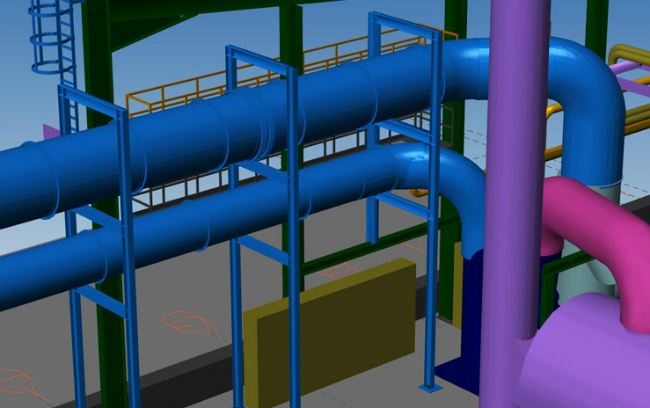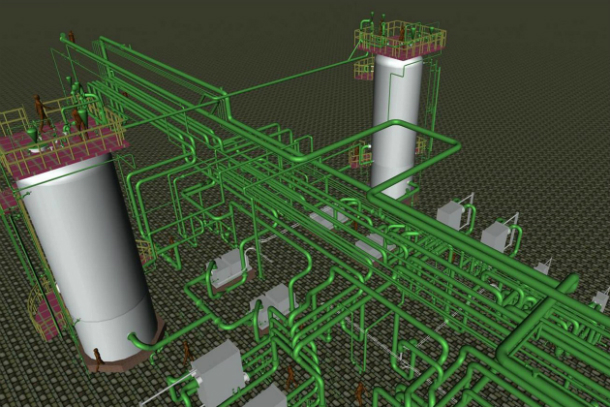
Different Load Cases in CAESAR II For Piping Stress Analysis
Piping Stress Analysis is the practice and discipline carried out behind the scenes of any piping design project to ensure structural and operational integrity, and optimal design. All piping systems are inevitably subjected to various kinds of loads in their design life cycle. These loads develop stresses in the arrangement. Pipe stress engineers typically analyze such systems for stress using reliable software such as Caesar II to check that the stress levels are within the permissible limits as defined by the codes/standards. The following are some of the most common type of loads considered during stress analysis.

Types of Loads:
- Thermal Loads at Various Operating Conditions
- Sustained Loads
- Seismic Loads
- Wind Loads
- PSV Reaction Force
- Slug Force
- Forces Induced by Surge Pressure
Thermal Loads at Various Operating Conditions
As temperature increases, so does the length of molecular bonds and solids typically expand on heating and contract on cooling. The dimensional response to temperature change is expressed by its coefficient in thermal expansion (CTE). Thus, to avoid “fatigue failure” resulting from cyclic thermal loads, the piping system should be made flexible (and not stiff).
Analysis Temperature
For thermal analysis, the design temperatures (minimum/maximum values as per line list) are used. If lines have design temperature higher than 80 deg. And the difference between operating and design temperature is more than 25 deg C then the maximum/minimum operating temperatures, as derived from Process Group, can be used in stress analysis instead of design temperature.
Additionally, Piping must also be analyzed for the normal operating temperature. Line Design Pressure defined in the Line List shall be considered as the analysis pressure.
Sustained Loads
Sustained loads exist throughout the plant’s operation. These mainly consist of internal pressure and dead-weight. Dead-weight is generally from weight of pipes, fittings, components such as valves, operating fluid, test fluid, insulation, cladding, lining etc. These are to be considered as follows:
- Design pressure
- Weight of Pipe and associated components such as Flanges, Valves, Strainer, Sight glass etc., mounted on the Piping System.
- Weight of Fluid/contents in the piping
- Insulation and cladding weight
- Hydro test loads, if applicable
- Snow load, if applicable
Different international piping codes have set the limits that are also called “allowable stresses for sustained loads”, on these axial stresses caused by dead-weight and pressure in order to avoid “failure by collapse”. To achieve the allowable stresses for sustained loads, it is often required to support the piping system vertically.
Seismic Loads
Projects that require Seismic design to be implemented, there needs to be an equivalent static seismic analysis in the software to evaluate seismic stresses, displacements and loads on the piping systems.
In case the Seismic coefficient has not been provided by the client, the calculation of static seismic co-efficient in terms of ‘g’ – as per project specific information must be calculated using relevant codes (UBC/ASCE/SNIP) and others. Here, the Seismic factor calculation document has to be attached to the project stress analysis document. Normal operating temperatures are used when considering occasional loads. Seismic loads are considered to be acting along the horizontal axes – along North, South, East, and West directions but not acting at the same time.
Occasional loads
These type of loads are imposed on piping by occasional events like wind, earthquake etc. Wind loads are considered for lines with external diameter 14” NB (including insulation) or above and at elevation 10 meters or higher from the ground level. Wind normally blows in the horizontal plane and to protect piping from wind, it is standard practice to attach lateral supports. In case of an earthquake, the earth seems to move vertically and to protect the piping against both horizontal/vertical movement, some resting supports might be constructed as integral two way lateral and vertical restraints. Normal operating temperature is used when analyzing occasional loads.
PSV Reaction Force
If the piping system in question includes PSV (pressure safety valve), then the reaction force due to PSV operation is considered as applicable. While analyzing PSV connected stress systems, the reaction force needs to be calculated. A dynamic load factor equal to 2.0 must be applied on the valve reaction force value. But in case of high reaction force values, the DLF value calculated as per appendix-II of ASME B31.1 should be used. This needs to consider valve data provided by vendor.
Slug Force
Slug force has to be considered in stress analysis for lines that have slug flow regime. It is calculated as follows:
Fslug = (ρ) (A) (V2) [2(1 – cos θ)]1/2 DLF
Where,
Fslug = Force due to slug in Newton.
ρ = Density of the slug in Kg/m3
A = Inside area of pipe cross section in m2,
V = Velocity of moving slug in m/sec.
θ = inclusion angle at elbow or change of direction
DLF = Dynamic Load Factor (DLF) equal to two shall be used, unless more accurate value is available.
Faxial = (ρ) (A) (V2) DLF
Forthogonal = (ρ) (A) (V2) DLF
Slug properties can be obtained from Process group.
The equivalent static analysis in Caesar-II is performed to simulate slug loading in piping system using the above formula for calculating slug force.
Forces Induced by Surge Pressure
The effect of surge on any line is also considered in stress analysis when identified by the Process group or a specialist agency. However it should be noted that two concurrent occasional loading shouldn’t be considered in stress analysis.
Piping Stress Analysis is a complex discipline – highly interwoven with piping layout and support design. Sufficient flexibility and proper routing are important for simplicity and economy of design. In spite of optimal design tools and sophisticated software, the best solutions are the ones that use clever engineering judgment, experience and foresight.
Looking for experienced piping engineering service provider for your pipe stress analysis requirement?
We have a strong quality track record with our clients even for most complex projects.
Call us now: 1-877-RISHABH (1-877-747-4224)
Or
Related Blogs
Related Blogs
Piping Support Design and Engineering
Pipe support design is an important component of piping engineering…
Detailed Engineering of Piping Systems
Detailed engineering involves design, detail, engineering and layout of piping…


